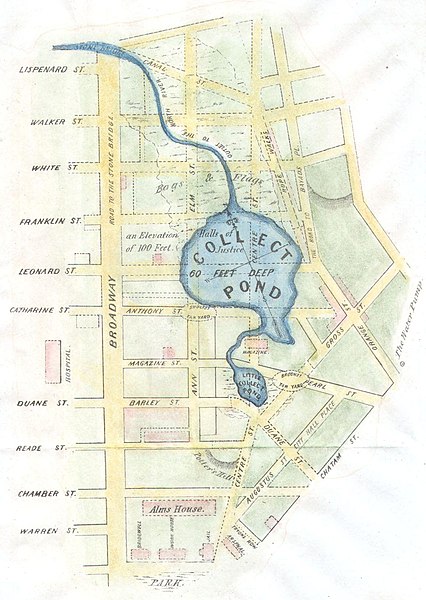
Original file (1,157 × 1,629 pixels, file size: 227 KB, MIME type: image/jpeg)
| This is a file from the
Wikimedia Commons. Information from its
description page there is shown below. Commons is a freely licensed media file repository. You can help. |
| Honor to Whom Honor is Due" Origin of Steam Navigation. A View of Collect Pond and Its Vicinity in the City of New York in 1793" | |||||||
|---|---|---|---|---|---|---|---|
| Artist | |||||||
| Title |
Honor to Whom Honor is Due" Origin of Steam Navigation. A View of Collect Pond and Its Vicinity in the City of New York in 1793" |
||||||
| Description |
English: An extremely scarce 1846 broadside issued by John Hutchings to promote the awareness of John Fitch as a pioneer of steam navigation. Fitch was an instrument maker working in the later part of the 18th century. As an early pioneer of steam navigation, Fitch tested several steamboats on the Delaware River between 1785 and 1788. One of these, the Perseverance, is depicted in the upper right quadrant of this sheet. Fitch’s real success, however, occurred a few years later when, in 1793 he tested another ship equipped with a paddle wheel on New York’s Collect Pond. This was a full six years before Fulton and Livingston launched “Fulton’s Folly” on the Seine. Hutchings claims to have been a “lad” at the time who “assisted Mr. Fitch in steering the boat”. Hutchings asserts that it was in fact Fitch who designed the steam propulsion mechanism. He claims that both Fulton and Livingston were present during the Collect Pond tests and in fact depicts both, as well as Fitch and himself, in a paddlewheel steam ship in the upper left quadrant. Though Fulton seems to have received most of the credit for the era of steam navigation, Hutchings hoped, through the publication of this broadside, to shed some light on Fitch’s contributions as well. Central to this publication is a map of the Collect Pond and vicinity extending roughly from Broadway westward to Chatam Street, south as far as City Hall Park and north to Canal. Roughly between Barlet Street and Franklin rested the Collect Pond, a natural depression and drainage area that filled with water seasonally. The Collect Pond appears in early maps of New York City and until the construction of the Croton Aqueduct was one of the few sources of fresh water in lower Manhattan. This pond was filled in around 1811 when it transformed into the notorious and poverty stricken Five Points district. When Fitch tested his steamboat the pond would have been surrounded by slaughterhouses, tanneries, gunpowder storage, bogs and prisons – not exactly a pretty place for an afternoon boat ride. The map image is surrounded by a brief biography of Fitch, signed attestations from important figures regarding the character of Fitch and Hutchings, and eye-witness accounts of the events in question. Right of the map is a description, written by Hutchings, describing the event and the Collect Pond vessel itself. Dated and copyrighted: “Entered according to act of Congress in the year 1846 by John Hutchings in the Clerk’s Office of the District Court of the Southern District of N.Y. |
||||||
| Date |
1846 date QS:P571,+1846-00-00T00:00:00Z/9 |
||||||
| Dimensions |
height: 14.5 in (36.8 cm); width: 18.5 in (46.9 cm) dimensions QS:P2048,14.5U218593 dimensions QS:P2049,18.5U218593 |
||||||
| Accession number |
Geographicus link:
CollectPond-hutchings-1846 |
||||||
| Source/Photographer |
|
||||||
| Permission ( Reusing this file) |
|
||||||
| Other versions |
|
||||||
Captions
Items portrayed in this file
depicts
image/jpeg
7a16bfa0139b037d4cfc6d63257f9659eb7e4184
232,264 byte
1,629 pixel
1,157 pixel
File history
Click on a date/time to view the file as it appeared at that time.
| Date/Time | Thumbnail | Dimensions | User | Comment | |
|---|---|---|---|---|---|
| current | 23:58, 15 May 2020 |
 | 1,157 × 1,629 (227 KB) | Vzeebjtf | File:1846 Broadside of the Collect Pond, New York and Steam Boat ( Five Points ) - Geographicus - CollectPond-hutchings-1846.jpg cropped 71 % horizontally, 49 % vertically using CropTool with lossless mode. |
File usage
Global file usage
The following other wikis use this file:
- Usage on es.wikipedia.org
- Usage on ja.wikipedia.org






